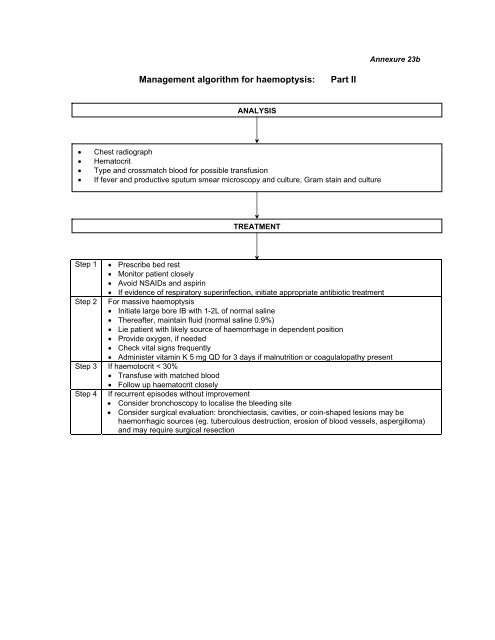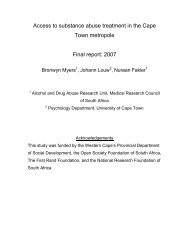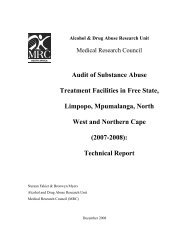Annexures 5 - SA HealthInfo
Annexures 5 - SA HealthInfo
Annexures 5 - SA HealthInfo
Create successful ePaper yourself
Turn your PDF publications into a flip-book with our unique Google optimized e-Paper software.
Annexure 23b<br />
Management algorithm for haemoptysis:<br />
Part II<br />
ANALYSIS<br />
• Chest radiograph<br />
• Hematocrit<br />
• Type and crossmatch blood for possible transfusion<br />
• If fever and productive sputum smear microscopy and culture, Gram stain and culture<br />
TREATMENT<br />
Step 1<br />
Step 2<br />
• Prescribe bed rest<br />
• Monitor patient closely<br />
• Avoid N<strong>SA</strong>IDs and aspirin<br />
• If evidence of respiratory superinfection, initiate appropriate antibiotic treatment<br />
For massive haemoptysis<br />
• Initiate large bore IB with 1-2L of normal saline<br />
• Thereafter, maintain fluid (normal saline 0.9%)<br />
• Lie patient with likely source of haemorrhage in dependent position<br />
• Provide oxygen, if needed<br />
• Check vital signs frequently<br />
• Administer vitamin K 5 mg QD for 3 days if malnutrition or coagulalopathy present<br />
Step 3 If haemotocrit < 30%<br />
• Transfuse with matched blood<br />
• Follow up haematocrit closely<br />
Step 4<br />
If recurrent episodes without improvement<br />
• Consider bronchoscopy to localise the bleeding site<br />
• Consider surgical evaluation: bronchiectasis, cavities, or coin-shaped lesions may be<br />
haemorrhagic sources (eg. tuberculous destruction, erosion of blood vessels, aspergilloma)<br />
and may require surgical resection

















